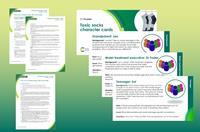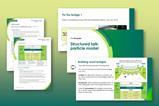Teach your students to understand the crucial role ethics plays in science by using case studies and active engagement
Ethics is generally understood to mean a set of moral values and principles. But, it is important to clarify that, while morals refers to aspects of human action, ethics refers to professional behaviour.

Scientific ethics are the standards of conduct for scientists in their professional endeavours. These include adherence to principles and practices of:
- valid scientific experimentation,
- education,
- peer review, and
- communication of results to the public.
Unethical behaviour and scientific misconduct include:
- falsification: the misrepresentation of results,
- fabrication: reporting on work never performed, and
- plagiarism: taking the writings or ideas of another and representing them as your own.
Scientific ethics are the standards of conduct for scientists in their professional endeavours. These include adherence to principles and practices of valid scientific experimentation, education, peer review and communication of results to the public.
Unethical behaviour and scientific misconduct include falsification: the misrepresentation of results; fabrication: reporting on work never performed; and plagiarism: taking the writings or ideas of another and representing them as your own.
Download this
Structured practice debate, for age range 11–14
Use the example of nanotechnology in socks to introduce ethics and society to your learners.
Download the resources from the Education in Chemistry website: rsc.li/3ledLP3
Active engagement
I engage students in activities rather than providing a list of do’s and don’ts. Students learn through getting involved in group discussions of case studies and reasoning through possible actions and outcomes for each case.
The key to choosing scenarios for discussion is to begin with characters and situations that students can identify with. The characters can have exaggerated behaviour yet must respond to the situation in a realistic manner. These cases can serve as an introduction to critical thinking, moral problem-solving and allow students to learn conventions or rules for appropriate conduct.
Case study
Students Mohamed, Brandon and Lisa are lab partners in their chemistry class.
Yesterday, Lisa was absent. This required Mohamed and Brandon to work diligently to complete the experiment so they could hand in the lab report the next day.
Today, Lisa has returned to school after being ill. She meets her lab partners on the way into school and asks them for the data from yesterday’s experiment so she can write it up and hand it in with theirs.
The question posed to students following presentation of this scenario is, ‘Should Mohamed and Brandon let Lisa copy their data?’. Invariably, students choose sides, and it is relatively easy to spark debate.
Some students feel that Mohamed and Brandon should not share the data, while others suggest it is the interpretation of the data that will count in the course, not the actual data. Frequently students contend that it does not matter since it is just a lab report.
If all students choose the same interpretation, you can introduce additional information. If, for example, all students think that the data should be shared, then you can place doubt in their minds by suggesting that Lisa may not have been ill, but was actually skipping school.
The point of this exercise is to get students to think about what they consider appropriate behaviour and why. Students may express the feeling that the scenario presents a trivial issue of no ethical importance. Ask them to consider who will be affected by the situation, and when they believe sharing data becomes an ethical issue and why.
Evaluate risks in practical science and the wider societal context, including perception of risk in relation to data and consequences. This approach provides the opportunity to discuss ‘right’ and ‘wrong’ answers without dictating a specific action.
Recommended reading and resources
- Discover a host of ethical case studies in the International Journal for Philosophy of Chemistry.
- Engage learners from 11–16 in the ethics of a global ban on fossil fuels with this structured debate.
- Stimulate learners aged 16–18 with this critical thinking and research activity looking at justice and injustice in drug development.
- Read Alan Regenberg talking to Katrina Megget about the ethics of gene editing.
- Introduce your learners to nanotoxicologist, Vicki.
- Read Alan Regenberg talking to Katrina Megget about the ethics of gene editing: rsc.li/40dEf3c
- Engage learners from 11–16 in the ethics of a global ban on fossil fuels with a structure debate: rsc.li/3JEys0K
- Stimulate post-16 learners with a critical thinking and research activity on justice and injustice in drug development: rsc.li/40CoMdc
- Discover a host of ethical case studies in the International Journal for Philosophy of Chemistry: bit.ly/3XRt3qI
- Introduce your learners to nanotoxicologist, Vicki: rsc.li/3jAqpXX
The ethics of science in society
Ethics provides great scope for debate in schools, whether stimulated by fiction, such as Mary Shelley’s Frankenstein or case studies, such as the thalidomide tragedy.
Collaborate with colleagues teaching subjects such as English literature, media, citizenship and PSHE to help with curriculum time pressures. In geography, the impact of agriculture on soil could draw on CRISPR crops or the use of fertilisers. Using Fritz Haber’s work on ammonia and chlorine gas would also create links with history.
The growth of research and technological proficiency offer new opportunities alongside more complex societal challenges on a global scale. Although science is based on trust, it is a social enterprise, which means that people and their personal agendas are involved. It is vital to understand the importance of teaching ethics as part of our science curriculum.

This article is part of our Teaching science skills series, bringing together strategies and classroom activities to help your learners develop essential scientific skills, from literacy to risk assessment and more.















1 Reader's comment